Abstract
Detection of chlamydial infections depends on the sensitivity of the techniques used. Variables include the number of body sites sampled, the number of samples obtained, and the number of passages in tissue culture. To assess these factors, microdilution plate cultures with a single blind passage were performed on specimens from 10,291 men and women attending a sexually transmitted disease clinic. Overall, 21% of the men and 30% of the women were culture positive. However, 18% of endocervical, 28% of female urethral, and 29% of male urethral cultures that were positive became so only after a single passage. Of culture-positive women, 23% were positive at the urethra only. Pooled urethral and endocervical specimens were positive more often than an endocervical specimen alone but less often than separately cultured endocervical and urethral specimens. A total of 221 specimens from 92 men and 66 women were subjected to five serial blind passages. Of 83 positive specimens, 29 (35%) were positive only after two or more passages. A total of 37 (46%) women were culture-positive, but only 12 (33%) of those who were positive and had an endocervical culture would have been detected by a single endocervical culture that was not passaged. The sensitivity of chlamydial culture is substantially less than 100% but can be improved by culturing samples from both the urethra and endocervix in women and by serial passage in tissue culture.
Full text
PDF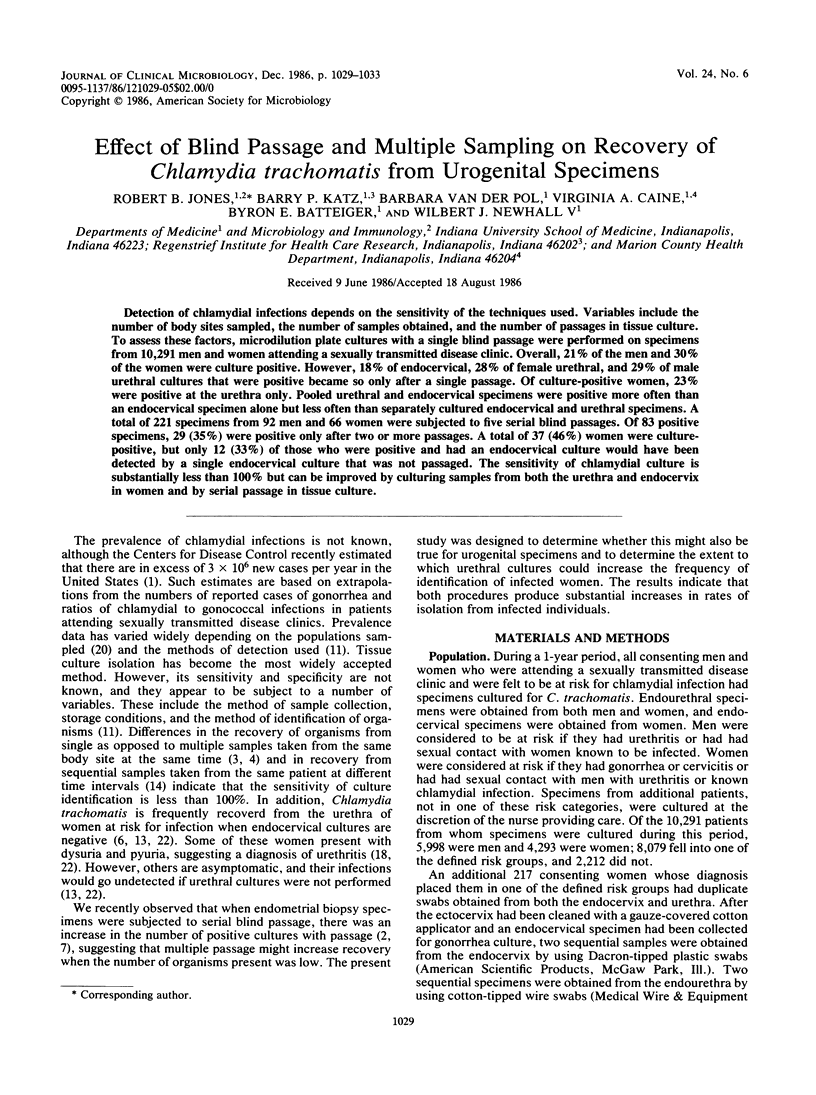
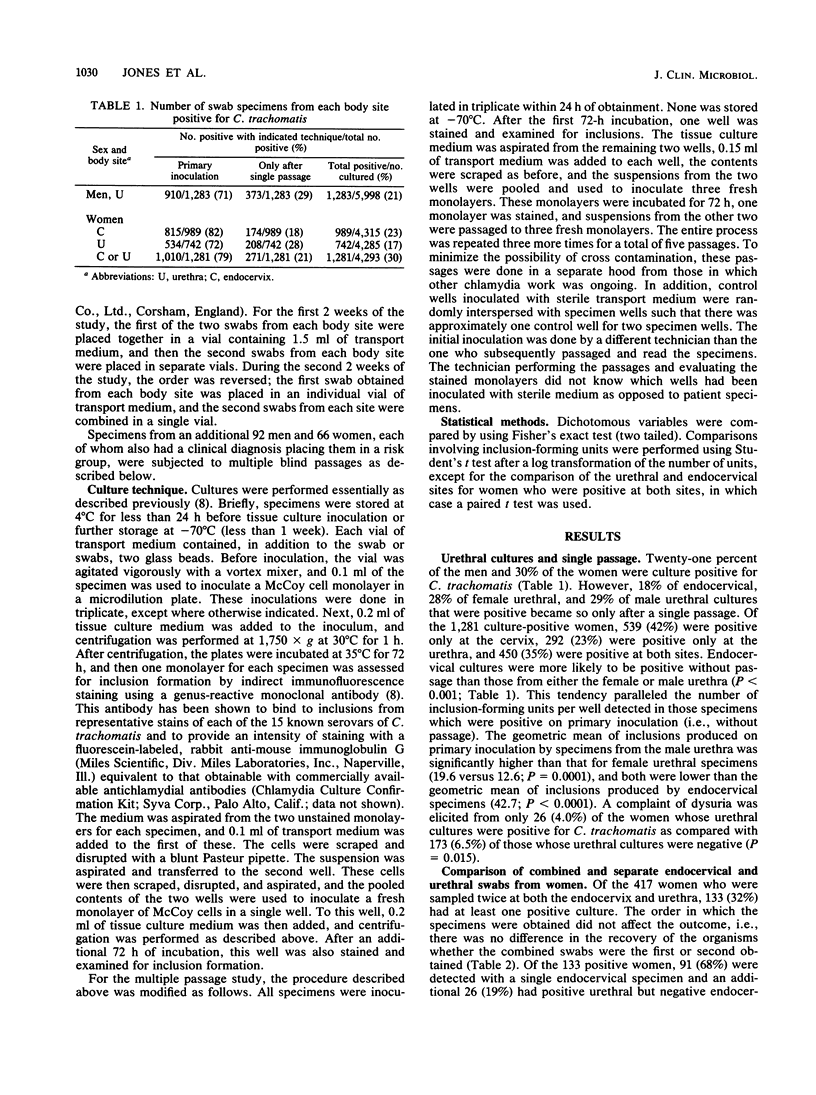
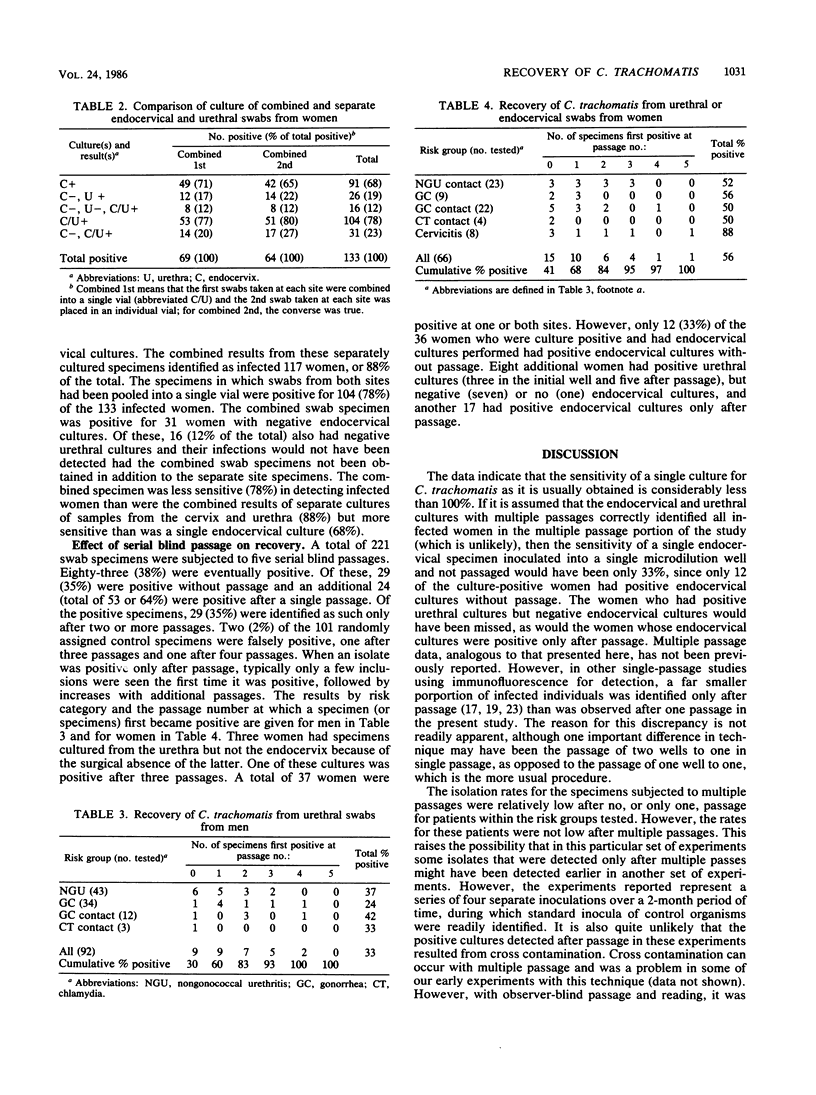
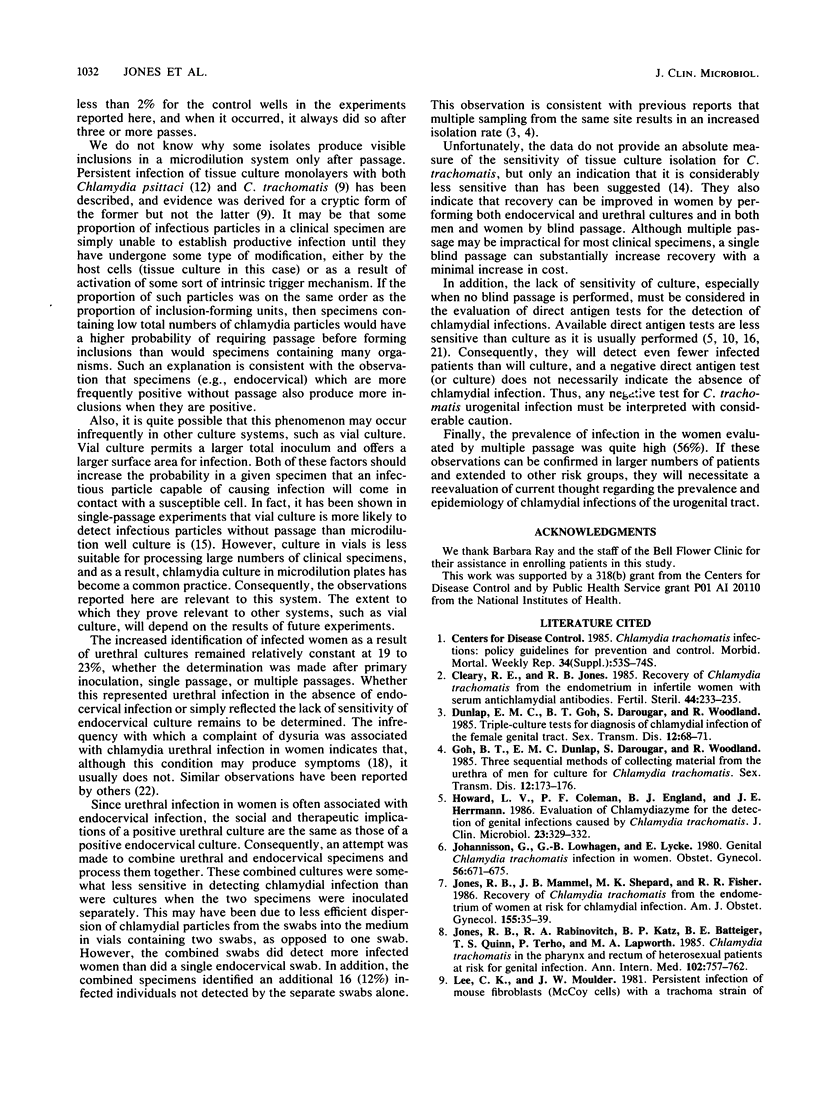
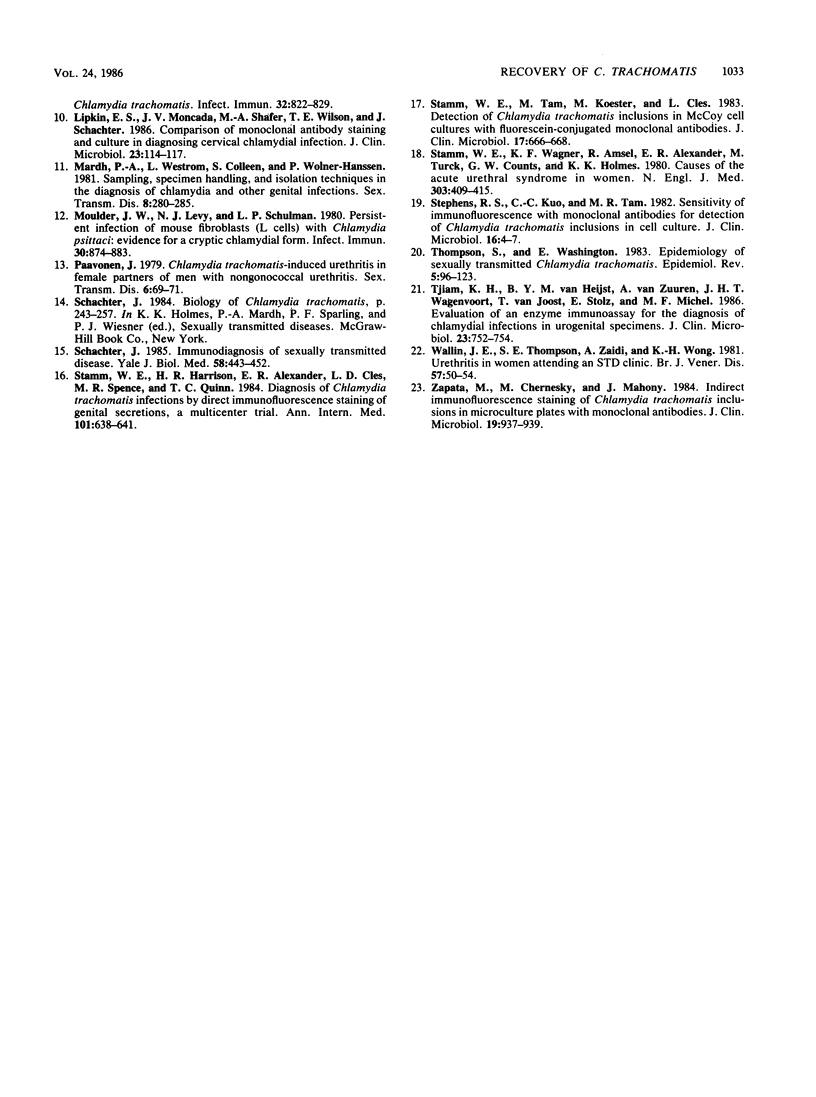
Selected References
These references are in PubMed. This may not be the complete list of references from this article.
- Cleary R. E., Jones R. B. Recovery of Chlamydia trachomatis from the endometrium in infertile women with serum antichlamydial antibodies. Fertil Steril. 1985 Aug;44(2):233–235. doi: 10.1016/s0015-0282(16)48743-1. [DOI] [PubMed] [Google Scholar]
- Dunlop E. M., Goh B. T., Darougar S., Woodland R. Triple-culture tests for diagnosis of chlamydial infection of the female genital tract. Sex Transm Dis. 1985 Apr-Jun;12(2):68–71. doi: 10.1097/00007435-198504000-00003. [DOI] [PubMed] [Google Scholar]
- Howard L. V., Coleman P. F., England B. J., Herrmann J. E. Evaluation of chlamydiazyme for the detection of genital infections caused by Chlamydia trachomatis. J Clin Microbiol. 1986 Feb;23(2):329–332. doi: 10.1128/jcm.23.2.329-332.1986. [DOI] [PMC free article] [PubMed] [Google Scholar]
- Johannisson G., Löwhagen G. B., Lycke E. Genital Chlamydia trachomatis infection in women. Obstet Gynecol. 1980 Dec;56(6):671–675. [PubMed] [Google Scholar]
- Jones R. B., Mammel J. B., Shepard M. K., Fisher R. R. Recovery of Chlamydia trachomatis from the endometrium of women at risk for chlamydial infection. Am J Obstet Gynecol. 1986 Jul;155(1):35–39. doi: 10.1016/0002-9378(86)90073-6. [DOI] [PubMed] [Google Scholar]
- Jones R. B., Rabinovitch R. A., Katz B. P., Batteiger B. E., Quinn T. S., Terho P., Lapworth M. A. Chlamydia trachomatis in the pharynx and rectum of heterosexual patients at risk for genital infection. Ann Intern Med. 1985 Jun;102(6):757–762. doi: 10.7326/0003-4819-102-6-757. [DOI] [PubMed] [Google Scholar]
- Lee C. K., Moulder J. W. Persistent infection of mouse fibroblasts (McCoy cells) with a trachoma strain of Chlamydia trachomatis. Infect Immun. 1981 May;32(2):822–829. doi: 10.1128/iai.32.2.822-829.1981. [DOI] [PMC free article] [PubMed] [Google Scholar]
- Lipkin E. S., Moncada J. V., Shafer M. A., Wilson T. E., Schachter J. Comparison of monoclonal antibody staining and culture in diagnosing cervical chlamydial infection. J Clin Microbiol. 1986 Jan;23(1):114–117. doi: 10.1128/jcm.23.1.114-117.1986. [DOI] [PMC free article] [PubMed] [Google Scholar]
- Moulder J. W., Levy N. J., Schulman L. P. Persistent infection of mouse fibroblasts (L cells) with Chlamydia psittaci: evidence for a cryptic chlamydial form. Infect Immun. 1980 Dec;30(3):874–883. doi: 10.1128/iai.30.3.874-883.1980. [DOI] [PMC free article] [PubMed] [Google Scholar]
- Mårdh P. A., Weström L., Colleen S., Wølner-Hanssen P. Sampling, specimen handling, and isolation techniques in the diagnosis of Chlamydial and other genital infections. Sex Transm Dis. 1981 Oct-Dec;8(4):280–285. doi: 10.1097/00007435-198110000-00007. [DOI] [PubMed] [Google Scholar]
- Paavonen J. Chlamydia trachomatis-induced urethritis in female partners of men with nongonococcal urethritis. Sex Transm Dis. 1979 Apr-Jun;6(2):69–71. doi: 10.1097/00007435-197904000-00005. [DOI] [PubMed] [Google Scholar]
- Schachter J. Immunodiagnosis of sexually transmitted disease. Yale J Biol Med. 1985 Sep-Oct;58(5):443–452. [PMC free article] [PubMed] [Google Scholar]
- Stamm W. E., Harrison H. R., Alexander E. R., Cles L. D., Spence M. R., Quinn T. C. Diagnosis of Chlamydia trachomatis infections by direct immunofluorescence staining of genital secretions. A multicenter trial. Ann Intern Med. 1984 Nov;101(5):638–641. doi: 10.7326/0003-4819-101-5-638. [DOI] [PubMed] [Google Scholar]
- Stamm W. E., Tam M., Koester M., Cles L. Detection of Chlamydia trachomatis inclusions in Mccoy cell cultures with fluorescein-conjugated monoclonal antibodies. J Clin Microbiol. 1983 Apr;17(4):666–668. doi: 10.1128/jcm.17.4.666-668.1983. [DOI] [PMC free article] [PubMed] [Google Scholar]
- Stamm W. E., Wagner K. F., Amsel R., Alexander E. R., Turck M., Counts G. W., Holmes K. K. Causes of the acute urethral syndrome in women. N Engl J Med. 1980 Aug 21;303(8):409–415. doi: 10.1056/NEJM198008213030801. [DOI] [PubMed] [Google Scholar]
- Stephens R. S., Kuo C. C., Tam M. R. Sensitivity of immunofluorescence with monoclonal antibodies for detection of Chlamydia trachomatis inclusions in cell culture. J Clin Microbiol. 1982 Jul;16(1):4–7. doi: 10.1128/jcm.16.1.4-7.1982. [DOI] [PMC free article] [PubMed] [Google Scholar]
- Thompson S. E., Washington A. E. Epidemiology of sexually transmitted Chlamydia trachomatis infections. Epidemiol Rev. 1983;5:96–123. doi: 10.1093/oxfordjournals.epirev.a036266. [DOI] [PubMed] [Google Scholar]
- Tjiam K. H., van Heijst B. Y., van Zuuren A., Wagenvoort J. H., van Joost T., Stolz E., Michel M. F. Evaluation of an enzyme immunoassay for the diagnosis of chlamydial infections in urogenital specimens. J Clin Microbiol. 1986 Apr;23(4):752–754. doi: 10.1128/jcm.23.4.752-754.1986. [DOI] [PMC free article] [PubMed] [Google Scholar]
- Wallin J. E., Thompson S. E., Zaidi A., Wong K. H. Urethritis in women attending an STD clinic. Br J Vener Dis. 1981 Feb;57(1):50–54. doi: 10.1136/sti.57.1.50. [DOI] [PMC free article] [PubMed] [Google Scholar]
- Zapata M., Chernesky M., Mahony J. Indirect immunofluorescence staining of Chlamydia trachomatis inclusions in microculture plates with monoclonal antibodies. J Clin Microbiol. 1984 Jun;19(6):937–939. doi: 10.1128/jcm.19.6.937-939.1984. [DOI] [PMC free article] [PubMed] [Google Scholar]


